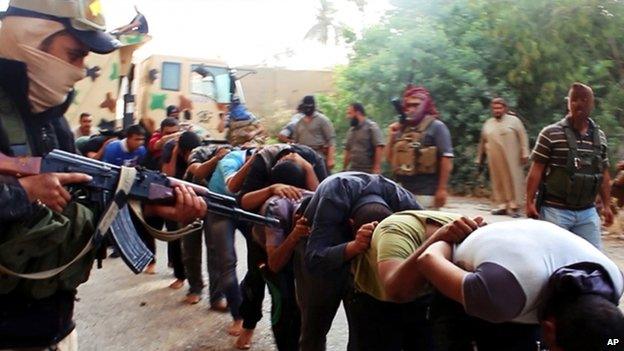Iraq 'Massacre' photos: What we know
- Published

The Iraqi army has said the photographs are genuine, but they have not been verified independently
Photographs posted online showing what appears to be a massacre of dozens of Iraqi soldiers by jihadist militants have caused international outrage.
What do the photos purportedly show?
One of the photo captions claims to show the "purification of hundreds of members of the Safavid army as they flee fighting in civilian clothing" by militants from the Islamic State in Iraq and the Levant (Isis), an al-Qaeda breakaway. Safavid is a derogatory term used by Sunni extremists to describe Iraq's Shia majority, linking it to the former Persian empire.
Some of the photos show dozens of unarmed men being transported on pick-up trucks by masked gunmen. A detailed Human Rights Watch report, external estimates that at least 160 were killed.
The captives are also seen lying down in trenches, surrounded by gunmen holding the black flags used by jihadist groups, including Isis.
Some images show small clouds of dust kick up as a row of gunmen seemingly open fire on the men.
Others too graphic to publish show the captives after their apparent execution, with what appears to be small pools of blood near their bodies.

Where did they come from?

Video footage of the incident has not yet been released
The photos first appeared on Twitter on 12 June after being posted by several accounts associated with Isis.
The captions claimed that they were taken in the northern Iraqi province of Salahuddin, without specifying where.
Human Rights Watch has analysed satellite images, external of the area and determined that two of the trenches where the men were apparently killed were located in central Tikrit.
The report also identified several individuals among the militants and the captives who were visible in multiple photos from various angles.

Why are there doubts about the authenticity of the pictures?
Chiefly because video footage of the incident has not yet been released.
Usually, Isis post videos of their operations, often with dramatic sound effects and graphics, external.
Videos are much harder to doctor than still images and their impact is arguably greater.
Isis did release video, external earlier on 12 June showing hundreds of men that it claimed were Iraqi prisoners of war, but it is not clear if these were the same men seen in the photos of the alleged massacre.
Another reason to doubt the Isis account is that we have not heard anything so far from the families of those killed. It could, however, be the case that the families are scared to speak out.

Haven't the pictures been confirmed by the Iraqi army?
Speaking days after the incident, Iraqi army spokesman Lt Gen Qassim al-Moussawi said the pictures were authentic and depicted events in Salahuddin province.
On 22 June, the Iraqi human rights minister, Mohammed Sudani, said that 175 air force recruits had been killed, with some of their bodies thrown into the Tigris River.
However, there has been no independent confirmation of the events by eyewitnesses, and accounts of the number killed in the incident vary widely, with Isis claiming that 1,700 Iraqi army soldiers were killed.

Would Isis do such a thing?

The hands of the men were not tied but they were surrounded by many gunmen
Isis has, by its own admission and backed up with video evidence, executed large numbers of Iraqi and Syrian soldiers in the past year, many of them tied up and shot in the back of the head.
What is unusual about this incident, however, is its apparent scale. The photos appear to show more than 50 men being killed.
If confirmed, the massacre would be one of the largest single atrocities committed in Iraq since the US-led invasion in 2003.